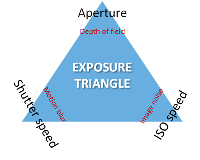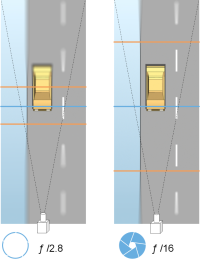Understanding camera exposure
Camera exposure determines how light/dark and sharp/blurry an image appears when it has been captured. This is determined by three camera settings: aperture, shutter speed, and ISO speed. Understanding their use and interdependency can help you to set up the camera correctly for LPR.
You can use different combinations of the three settings to achieve the same exposure. The key is to know which trade-offs to make, since each setting also influences the other image settings:
|
Camera settings |
Controls... |
Affects... |
|---|---|---|
|
Aperture |
The adjustable opening that limits the amount of light to enter the camera |
Depth of field |
|
Shutter speed |
The duration of the exposure |
Motion blur |
|
ISO speed |
The sensitivity of the camera's sensor to a given amount of light |
Image noise |
The next sections describe how each setting is specified, what it looks like, and how a given camera exposure mode affects this combination:
Aperture settings
The aperture setting controls the amount of light that enters your camera from the lens. It is specified in terms of an f-stop value, which can at times be counterintuitive, because the area of the opening increases as the f-stop decreases.
Low f-stop value/wide aperture = shallow depth of field
High f-stop value/narrow aperture = large depth of field
The example illustrates how the depth of field is affected by the f-stop value. The blue line indicates the focus point.
A high f-stop value makes it possible to have a longer distance where the license plate is in focus. Good light conditions are important for sufficient exposure. If lighting conditions are insufficient, the exposure time needs to be longer, which again increases the risk of getting blurry images.
A low f-stop value reduces the focus area and thereby the area used for recognition, but is suitable for conditions with low light. If it is possible to ensure that vehicles are passing the focus area at a low speed, a low f-stop value is suitable for a consistent recognition.
Shutter speed
A camera's shutter determines when the camera sensor is open or closed for incoming light from the camera lens. The shutter speed refers to the duration when the shutter is open and light can enter the camera. Shutter speed and exposure time refer to the same concept, and a faster shutter speed means a shorter exposure time.
Motion blur is undesired for license plate recognition and surveillance. In many occasions vehicles are in motion while license plates are detected which makes a correct shutter speed an important factor. The rule of thumb is to keep the shutter speed high enough to avoid motion blur, but not too high as this may cause under-exposed images depending on light and aperture.
ISO speed
The ISO speed determines how sensitive the camera is to incoming light. Similar to shutter speed, it also correlates 1:1 with how much the exposure increases or decreases. However, unlike aperture and shutter speed, a lower ISO speed is in general desirable, since higher ISO speeds dramatically increase image noise. As a result, ISO speed is usually only increased from its minimum value if the desired image quality is not obtainable by modifying the aperture and shutter speed settings solely.
Low ISO speed image vs High ISO speed image
Common ISO speeds include 100, 200, 400 and 800, although many cameras also permit lower or higher values. With digital single-lens reflex (DSLR) cameras, a range of 50-800 (or higher) is often acceptable.





